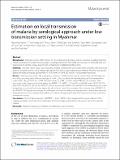Files in this item
Estimation on local transmission of malaria by serological approach under low transmission setting in Myanmar
Item metadata
| dc.contributor.author | Nyunt, Myat Htut | |
| dc.contributor.author | Soe, Than Naing | |
| dc.contributor.author | Shein, Thinzar | |
| dc.contributor.author | Zaw, Ni Ni | |
| dc.contributor.author | Han, Soe Soe | |
| dc.contributor.author | Muh, Fauzi | |
| dc.contributor.author | Lee, Seong-Kyun | |
| dc.contributor.author | Han, Jin-Hee | |
| dc.contributor.author | Park, Ji-Hoon | |
| dc.contributor.author | Ha, Kwon-Soo | |
| dc.contributor.author | Park, Won Sun | |
| dc.contributor.author | Hong, Seok-Ho | |
| dc.contributor.author | Kyaw, Myat Phone | |
| dc.contributor.author | Han, Eun-Taek | |
| dc.date.accessioned | 2019-07-18T12:30:03Z | |
| dc.date.available | 2019-07-18T12:30:03Z | |
| dc.date.issued | 2018-01-05 | |
| dc.identifier | 259673650 | |
| dc.identifier | 56e036c4-d430-43b5-8d4f-2e494c4ce7e3 | |
| dc.identifier | 000419605500005 | |
| dc.identifier | 85056803002 | |
| dc.identifier.citation | Nyunt , M H , Soe , T N , Shein , T , Zaw , N N , Han , S S , Muh , F , Lee , S-K , Han , J-H , Park , J-H , Ha , K-S , Park , W S , Hong , S-H , Kyaw , M P & Han , E-T 2018 , ' Estimation on local transmission of malaria by serological approach under low transmission setting in Myanmar ' , Malaria Journal , vol. 17 , 6 . https://doi.org/10.1186/s12936-017-2170-8 | en |
| dc.identifier.issn | 1475-2875 | |
| dc.identifier.other | ORCID: /0000-0002-3966-9110/work/59698777 | |
| dc.identifier.uri | https://hdl.handle.net/10023/18126 | |
| dc.description.abstract | Background: As the prevalence of the malaria has been decreasing in many endemic countries including Myanmar, malaria elimination in Greater Mekong Region was targeted not later than 2030. The relevance of molecular and serological tools to identify residual transmission remains to be established in this setting. Methods: One-year cohort study was conducted and sera samples were collected in every 3 months with active and passive case detection for clinical malaria episodes by RDT, microscopy and molecular method. The sera were used to detect the malaria antibody against PfMSP1-19, PvAMA1, PvDBPII and PvMSP1-19 by protein microarray. Results: Among the recruited 1182 participants, there was no RDT positive case for malaria infection although two vivax infections were detected by microscopy in initial collection. Molecular methods detected the asymptomatic cases of 28/1182 (2.37%) in first, 5/894 (0.42%) in second, 12/944 (1.02%) in third, 6/889 (0.51%) in fourth collection, respectively. Seropositivity rates against the PfMSP1-19, PvMSP1-19, PvAMA1 and PvDBPII were 73/270 (27.0%), 85/270 (31.5%), 65/270 (24.1%) and 160/270 (59.3%), respectively. PfMSP1-19 and PvMSP1-19 showed high and stable antigenicity in acute and subacute samples but declining in 1-year history samples. No cross reactivity of PfMSP1-19 and PvMSP1-19 between the two species and higher seropositivity among the asymptomatic carriers were observed. Mapping data indicated serological surveillance can detect the geographical pattern of malaria infection under low transmission setting. Conclusions: These findings support that PfMSP1-19 and PvMSP1-19 are suggested for serosurveillance of the malaria especially in low transmission setting for further necessary actions have to be carried out to eliminate the malaria. | |
| dc.format.extent | 9 | |
| dc.format.extent | 2904324 | |
| dc.language.iso | eng | |
| dc.relation.ispartof | Malaria Journal | en |
| dc.subject | Malaria | en |
| dc.subject | Serological surveillance | en |
| dc.subject | Asymptomatic cases | en |
| dc.subject | Myanmar | en |
| dc.subject | QH301 Biology | en |
| dc.subject | RC Internal medicine | en |
| dc.subject | NDAS | en |
| dc.subject | SDG 3 - Good Health and Well-being | en |
| dc.subject.lcc | QH301 | en |
| dc.subject.lcc | RC | en |
| dc.title | Estimation on local transmission of malaria by serological approach under low transmission setting in Myanmar | en |
| dc.type | Journal article | en |
| dc.contributor.institution | University of St Andrews. School of Medicine | en |
| dc.identifier.doi | https://doi.org/10.1186/s12936-017-2170-8 | |
| dc.description.status | Peer reviewed | en |
This item appears in the following Collection(s)
Items in the St Andrews Research Repository are protected by copyright, with all rights reserved, unless otherwise indicated.

